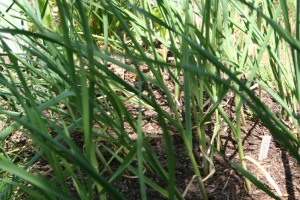2011 was quite a challenging season for the vegetable gardener: we had a very dry, hot spring, followed by a moderately warm and dry summer, with few warm evenings, which got amazingly wet and warm come August (ideal for tomato blight), and then stunningly hot at the very end of September and into October.
Here’s five of the things I learnt this year:
1. Plant garlic early! It needs a long cool growing season, if it’s not to come crashing to a halt in our newly hot, dry springs. I put a lot in, late March, and didn’t get much out: the best was some I’d accidentally left in from last year. I’m thinking of putting some bulbs in now, rather than waiting for the shortest day: some escapees from this year are already growing nicely.
2. Plant-out French beans later! I planted some French beans out early (mid-April), thinking that it was later than my disaster last year; but like last year, these beans got most of their leaves blown off immediately, the tops shrivelled and died in the wind and cold, and they never really recovered. The beans I planted out in mid-May did absolutely fine.
3. Don’t over-fertilize Runner beans (or probably any beans). I improved one of the flower beds this year, cutting an overgrown box (Buxus sempervirens “Latifolia maculate”) to the ground (don’t worry, it’s coming back, with a vengeance!), digging lots of manure in, and planting flowering perennials. To hide the newly bare fence, and applying my new rule of using every available space, horizontal and vertical, I planted Runner beans at the rear of the bed, to climb up the fence. There was a major flaw in this idea: the manure I’d put on the bed created a stunning display from the flowering perennials, but the beans bolted up the fence, grew an amazing amount of foliage, and produced very few flowers! It wasn’t until very late in the summer, when, I guess, nutrient levels had declined, that they actually decided to set flower. I’ve had a fine harvest since, but I really could have done with those beans a bit earlier…
4. Try growing Lettuce in containers. I’ve never had much luck with lettuce in the ground; the green stuff always got eaten by the slugs, and, although the red stuff was less attractive to them, it’s also (generally) less tasty to humans too. This year I bought some large troughs and grew Cos and an Oriental mix (Pak Choi, Mizuna, Mibuna, Komatsuna), and it did very well. You need to keep the containers from drying out, else the lettuce will go to seed, so I put them in partial shade, and watered often. To discourage slugs I liberally applied a layer of horticultural grit. I’ve had the best lettuce crop ever; a successional late planting of the Oriental mix and pure Mizuna is also growing well.
5. Always drill holes in containers! The house came with an old dustbin that’s been stuck under the stairs ever since; this year I decided I’d grow potatoes in it. Being clever, I thought, what with a dry spring, the seemingly enormous volume of compost, relatively small surface area, and the fact that I’d had problems keeping potatoes watered with previous attempts at growing them in specially-designed (?) potato bags, I thought I wouldn’t need drainage holes. How wrong I was! One day I pulled out a stick that I’d put in there as part of my squirrel defences, and realised the whole bin was a saturated, anaerobic mess. A few hastily drilled holes later and about 10 litres of rather putrid water drained out… luckily, the potatoes (Anya) subsequently did quite well. I made the same mistake with a little soap dish my wife had identified for growing violets: the first lot rotted off where the stem met the compost… a little hole drilled in the base, and they grew fine.
What did well this year
- Runner bean Scarlet Emperor – forgetting the earlier problem,
- French climbing bean Blauhilde – still going, just about,
- Cos Lettuce Parris Island,
- Mizuna (Brassica rapa nipposinica) – seems very tolerant of varied conditions,
- Tomato Gardener’s Delight – cherries ripened before the blight set in,
- Spring cabbage Greyhound,
- Radicchio Treviso Precoce Mesola – sown late July, nearly ready to eat full heads,
- Strawberries – excellent, tasty, late summer 2nd crop, 1st crop so-so, but I do wish the squirrels would leave them alone!
What did badly this year
- Courgette Green Bush – Powdery mildew pretty much finished them off, just as they really got stared, think everyone got this, may try a more resistant variety next year,
- Tomatoes Roma VF, Moneymaker, San Marzano 2 – the larger tomatoes all grew very well, but then, just as the fruits started to ripen, quickly succumbed to blight; don’t think I’ll bother growing anything other than cherry tomatoes outdoors again,
- Swiss Chard/Leaf Beet – first lot bolted in hot spring, second lot just sat around sulking, then got leaf-miner-ed to bits, may return to good old white-stemmed ‘silver beet’ next year, although I’ve got a late sowing in containers: we’ll see how that does, although it’s already looking a bit sulky!
- Spinach Renegade F1, Scenic F1 – bolted immediately due to hot, dry spring, may try in containers next year.
Another thing that always seems not to go so well is my Garden Journal! I always start well, logging the winter weather and sowing and planting in March and April, but soon forget to write anything else until Autumn, by which time my memory is poor, the dates I wrote on plant labels have all been washed off, or the labels lost or confused, and I have to look at photos to guess dates! Fortunately, I take a lot of photos!




